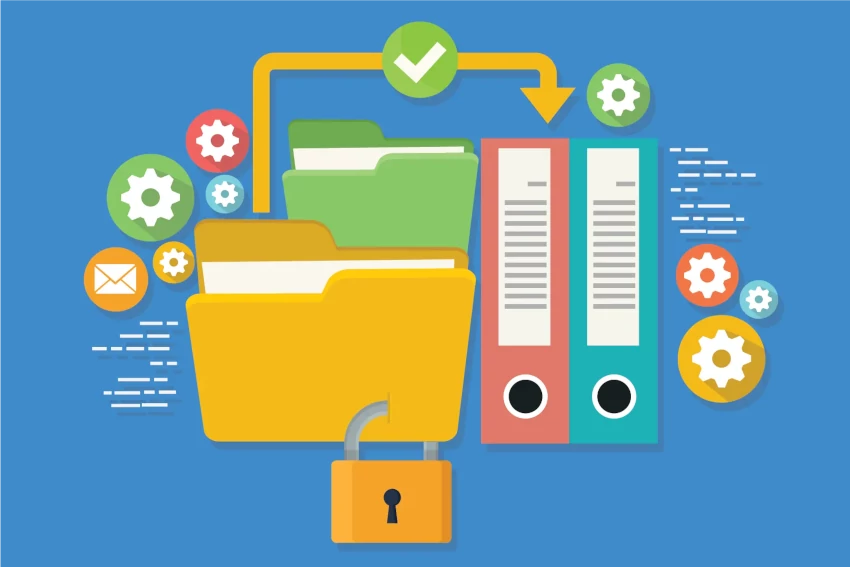Next-Level Strategies for File Sharing in 2024: Expert Tips and Insights
With the arrival of 2024 and the third millennium in general, file sharing has become an essential part of our daily lives. Whether it's sharing documents with colleagues, collaborating with remote teams, or sending files to clients, file sharing is a necessary tool for businesses and individuals alike. However, with the rise of cyber threats, it's becoming increasingly important to implement next-level strategies to ensure the security and privacy of our shared files.

In this article, we will explore the latest trends and technologies in file sharing, and provide you with actionable tips to take your file sharing to the next level. We'll cover everything from secure file sharing platforms to best practices for sharing sensitive information. With our expert insights, you'll be able to implement the latest strategies and tools to keep your files secure and protected in 2024 and beyond.
Advanced File Sharing Technologies
File sharing technologies are becoming more advanced, secure, and efficient. In this section, we will explore some of the emerging technologies that are transforming the way we share files.
Blockchain-Based Solutions
Blockchain technology is revolutionizing many industries, and file sharing is no exception. Blockchain-based solutions provide a secure and decentralized way to share files, eliminating the need for intermediaries and reducing the risk of data breaches. With blockchain-based file sharing, files are encrypted and stored on a distributed network, making them virtually impossible to hack or tamper with. This technology is particularly useful for industries that require high levels of security, such as healthcare, finance, and government.
AI-Enhanced Systems
Artificial intelligence (AI) is transforming the way we share files by automating many of the processes involved in file sharing. AI-enhanced systems can automatically categorize files, detect anomalies, and flag potential security threats. With AI, file sharing becomes more efficient and secure, allowing us to focus on more important tasks. AI can also improve collaboration by providing real-time feedback and insights, making file sharing more intuitive and user-friendly.
Peer-to-Peer Innovations
Peer-to-peer (P2P) file sharing has been around for decades, but recent innovations are making it more efficient and secure. P2P file sharing allows users to share files directly with each other, without the need for intermediaries. This technology is particularly useful for large files, as it allows users to share files without relying on centralized servers. With P2P file sharing, files are encrypted and distributed across multiple devices, making them more secure and less vulnerable to hacking.
In conclusion, advanced file sharing technologies are transforming the way we share files, making it more efficient, secure, and user-friendly. Blockchain-based solutions, AI-enhanced systems, and P2P innovations are just a few of the emerging technologies that are shaping the future of file sharing. This year, we can expect to see more advanced technologies that will continue to improve the way we share files.
Enhancing Security in File Sharing
At the heart of secure file sharing in 2024 lies the use of robust encryption techniques, access control measures, and compliance with regulations. In this section, we'll discuss these three aspects in detail.
Encryption Techniques
Encryption is a vital part of secure file sharing. It involves the use of cryptographic algorithms to convert plain text into ciphertext, which can only be deciphered using a secret key. In 2024, we expect to see the use of advanced encryption algorithms such as AES-256 and RSA-4096 to secure files during transmission and storage.
In addition to encryption, we also recommend the use of digital signatures to ensure the integrity of files. Digital signatures use public-key cryptography to verify the authenticity of a file and ensure that it has not been tampered with during transmission.
Access Control
Access control is another critical aspect of secure file sharing. It involves the use of authentication and authorization mechanisms to ensure that only authorized users can access files. In 2024, we expect to see the use of multi-factor authentication (MFA) and biometric authentication to enhance access control.
MFA involves the use of multiple authentication factors such as passwords, security tokens, and biometrics to verify the identity of a user. Biometric authentication, on the other hand, uses unique physical characteristics such as fingerprints and facial recognition to authenticate users.
Compliance and Regulations
Compliance with regulations is essential for secure file sharing in 2024. We expect to see the continued adoption of regulations such as GDPR and HIPAA, which require organizations to protect sensitive data and ensure the privacy of individuals.
To comply with these regulations, organizations must implement robust security measures such as encryption, access control, and data backup and recovery. They must also conduct regular security audits and risk assessments to identify and mitigate potential security threats.
In conclusion, enhancing security in file sharing is critical in 2024. By using robust encryption techniques, access control measures, and compliance with regulations, organizations can ensure the privacy and integrity of their files.
Optimizing File Sharing for Business
As businesses continue to grow and expand, the need for efficient and secure file sharing becomes more critical. To maximize productivity and streamline workflows, it is essential to optimize file sharing strategies. Here are some next-level strategies that businesses can implement in 2024 to optimize their file sharing capabilities:
Collaboration Tools Integration
One of the most important aspects of file sharing is collaboration. Integrating collaboration tools such as Microsoft Teams, Slack, or Zoom into file sharing platforms can significantly improve communication and collaboration among team members. These tools can also help team members work together on files in real-time, reducing the need for back-and-forth emails and file versions.
Workflow Automation
Workflow automation is another critical aspect of optimizing file sharing for business. By automating routine tasks, businesses can save time and reduce errors. Automating tasks such as file routing, approvals, and notifications can ensure that files are shared with the right people at the right time, without manual intervention.
Furthermore, DriveUploader offers an additional feature that takes workflow automation to the next level. Users can design custom forms and seamlessly integrate them into their file sharing process. This allows businesses to not only share files but also collect and organize data from clients or collaborators in a structured manner. Clients can fill in essential data directly within the forms while uploading or sharing files, streamlining the entire process and enhancing collaboration efficiency.
Analytics and Reporting
Analytics and reporting can provide valuable insights into file sharing activities. By tracking metrics such as file usage, access, and downloads, businesses can identify areas for improvement and optimize their file sharing strategies accordingly. Analytics and reporting can also help businesses monitor compliance and identify potential security risks.
In conclusion, optimizing file sharing for business requires a multifaceted approach that includes collaboration tools integration, workflow automation, and analytics and reporting. By implementing these next-level strategies, businesses can improve productivity, streamline workflows, and enhance security.
Future of File Sharing
File sharing continues to be a critical aspect of business operations. With the increasing need for remote work and collaboration, file sharing is more important than ever. In this section, we will explore the future of file sharing, including predictive developments, sustainability considerations, and global connectivity.
Predictive Developments
One of the most exciting developments in file sharing is the use of predictive analytics. This technology uses machine learning algorithms to analyze data and predict future trends. In the context of file sharing, predictive analytics can be used to anticipate the needs of users and provide them with the right files at the right time. This can help to streamline workflows and improve productivity.
Sustainability Considerations
As we become more aware of the impact of our actions on the environment, sustainability considerations are becoming increasingly important in every aspect of business. When it comes to file sharing, there are a number of ways to reduce our environmental impact. For example, we can use cloud-based file sharing solutions to reduce the need for physical storage devices. We can also encourage users to share files electronically rather than printing them out.
Global Connectivity
As businesses become more global, file sharing is becoming increasingly important for international collaboration. However, there are a number of challenges associated with global file sharing, such as differences in time zones and language barriers. To address these challenges, we need to develop file sharing solutions that are accessible to users around the world. This might involve developing multilingual interfaces or incorporating translation tools into file sharing platforms.
In conclusion, file sharing will continue to be a critical aspect of business operations in 2024 and beyond. By embracing predictive analytics, sustainability considerations, and global connectivity, we can ensure that file sharing is efficient, effective, and environmentally responsible.
Frequently Asked Questions
How can businesses enhance cyber security in file sharing for 2024?
In 2024, businesses can enhance cyber security in file sharing by adopting a zero-trust architecture. This approach ensures that no user or device is trusted by default, and every access request is verified before granting access to sensitive information. Additionally, businesses can implement multi-factor authentication, data encryption, and regular security audits to ensure that their file-sharing practices are secure.
What are the most secure methods for sharing documents in a business setting?
The most secure methods for sharing documents in a business setting include using encrypted file-sharing services, implementing access controls, and ensuring that all devices used for file sharing are secure and up-to-date. Additionally, businesses can use virtual private networks (VPNs) to secure data in transit and prevent unauthorized access. According to Cybernews, exploring free VPN services can be a good starting point for businesses looking to enhance their security without committing to paid solutions, though it's essential to choose a reputable provider.
What steps are essential for configuring secure file sharing in the cloud?
To configure secure file sharing in the cloud, businesses should first identify the data that needs to be shared and determine who needs access to it. They should then select a cloud service provider that offers robust security features, such as data encryption, access controls, and regular security audits. Businesses should also ensure that their cloud service provider complies with industry regulations and standards, such as HIPAA and GDPR.
What advancements are expected in the future of file sharing technology?
In the future, we can expect advancements in file sharing technology that focus on improving security, scalability, and ease of use. For example, blockchain-based file sharing platforms are expected to become more prevalent, offering enhanced security and transparency. Additionally, artificial intelligence (AI) and machine learning (ML) technologies are expected to be integrated into file sharing platforms, making it easier to manage and share large volumes of data.
Which file sharing programs are leading the market in 2024 for security and efficiency?
In 2024, the file sharing programs that are leading the market for security and efficiency include Dropbox, Egnyte, Google Drive, and Tresorit. These platforms offer robust security features, such as data encryption, access controls, and multi-factor authentication, while also providing users with an intuitive and efficient user experience.
By facilitating direct uploads to Google Drive, DriveUploader simplifies file management and enhances the overall file sharing experience. This powerful combination of Google Drive and DriveUploader has emerged as the go-to solution for modern-day file sharing, offering users a secure and user-friendly means to exchange files in today's digital landscape.
What best practices should be included in a file sharing policy for modern businesses?
Modern businesses should include several best practices in their file sharing policy, including defining clear guidelines for data sharing, implementing access controls, and ensuring that all devices used for file sharing are secure and up-to-date. Additionally, businesses should provide regular training to employees on safe file sharing practices and conduct regular security audits to ensure that their file sharing policies are effective.




